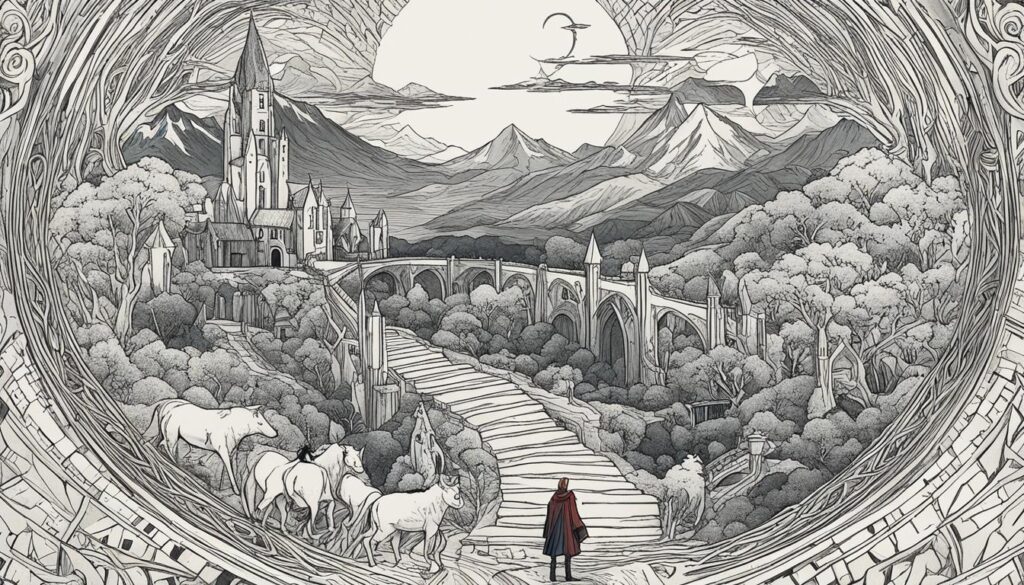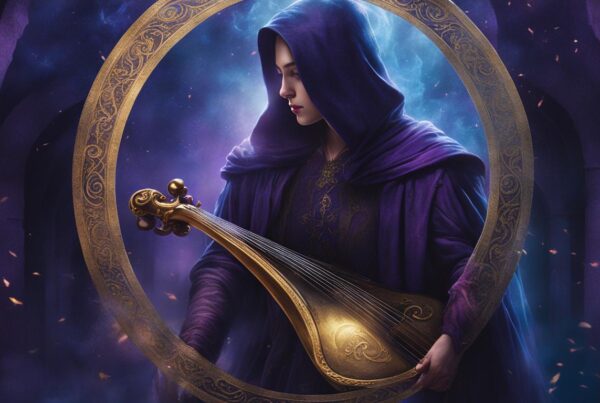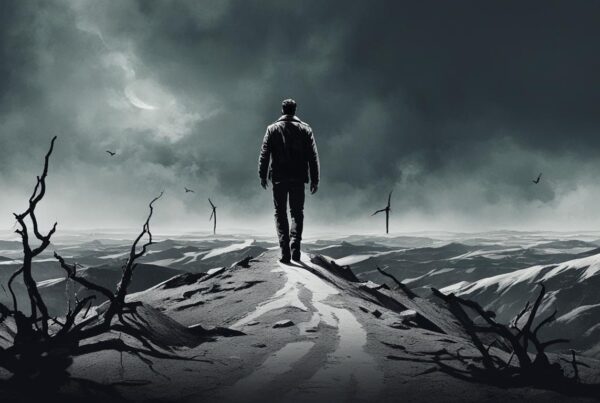Delving into the haunting depths of J.R.R. Tolkien’s narrative mastery, the audiobook of “The Children of Húrin” presents an opportunity for epic fantasy enthusiasts and literary scholars alike to experience Middle-earth in a resonantly new way. This review centers on the intricacies of Tolkien’s storytelling—the tragic lives of its characters, the intricate lore of Middle-earth, and the capacious imagination that shaped a genre. As we embark upon this literary analysis, we uncover the layers of an eternal saga set in the vast expanses of a mythic world that continues to mesmerize audiences.
Distinguished by its complex tale of fate and sorrow, “The Children of Húrin” stands as a testament to the grand scale of high fantasy. J.R.R. Tolkien, whose namesakes include “The Lord of the Rings,” laid the foundation for what has since become a bedrock of the genre. Our audiobook review explores the textures and tones that breathe life into this epic narrative, inviting listeners to traverse the ancient landscapes of Middle-earth once more through the spoken word.
Introduction to “The Children of Húrin”
Delving into the annals of high fantasy, few names ring as clear and as vital as that of J.R.R. Tolkien. Among his venerable body of work, “The Children of Húrin” stands as a gripping epic narrative that embodies the intricate detailing and mythological depth characteristic of Tolkien’s legacy. This integral piece of literature not only expands the mythos of Middle-earth but also establishes its own significance within the fantasy genre.
Posthumously published, “The Children of Húrin” coalesces from Tolkien’s extensive legendarium, offering a literary introduction to tales that prelude the events well known to admirers of “The Lord of the Rings” and “The Hobbit”. The narrative, which draws upon the tragic fates of Húrin’s offspring, echoes with the somber tones of heroic sagas and sheds light on the tumultuous history of Middle-earth’s First Age.
“Morgoth took Húrin, set him upon a chair of stone upon a high place of Thangorodrim. There he was bound by the power of Morgoth, and Morgoth standing beside him cursed him with slow words of malice that went to the marrow of Húrin’s bones; and he cursed also his kin and all their offspring after them.” – “The Children of Húrin”
The inspiration for “The Children of Húrin” can be traced back to ancient epics and folklore, a testament to Tolkien’s academic background as a philologist and a scholar. For admirers and students of Tolkien’s legacy, this narrative serves not only as a rich addition to Middle-earth’s lore but also as an opportunity to witness Tolkien’s storytelling prowess in its prime.
- Ancestry of Middle-earth’s Lore
- The Tragic Depth of Tolkien’s Storytelling
- Symbolism and Significance in Fantasy Literature
As we venture through this introduction, it is essential to recognize “The Children of Húrin” as more than just a tale of fantasy; it is an enduring piece of literary art that reflects the profound imagination and intellectual heft of its author. J.R.R. Tolkien’s creative genius presents readers with a world that, while set in an age far removed from our own, deals with themes and emotions timelessly resonant — honor, defiance, fate, and redemption.
Exploring Tolkien’s World in “The Children of Húrin”
Delving into the expansive lore of J.R.R. Tolkien, “The Children of Húrin” unfurls the elaborate tapestry of Middle-earth’s First Age. This era is marked by its complex mythology and labyrinthine plots, forming the bedrock of Tolkien’s fantasy world-building. It is in these primordial days that the tragic tale of Turin Turambar is etched into the annals of epic saga.
Setting the Stage: Middle-earth’s First Age
Deciphering the narrative’s setting, readers embark on a journey through the First Age, an epoch where the very foundations of Middle-earth’s history were laid. This period is renowned for its mythical resonance, where the grandeur of the fantasy world-building touches monumental heights. images of forgotten realms steeped in ageless grandeur fill the pages.
Key Locations in the Tale
In the labyrinth of the First Age, Tolkien’s storytelling brilliance shines through the portrayal of Beleriand and Menegroth. These pivotal locations are more than mere backdrops; they encapsulate the saga’s essence.
| Beleriand | Menegroth |
|---|---|
| Heart of many pivotal conflicts | Renowned Thousand Caves city |
| Land of the Noldorin and Sindarin Elves | Seat of King Thingol and Queen Melian |
| Delineates the cultural diversity of Elvendom | Symbol of Elven architecture and lore |
The intricate descriptions of these domains bestow a richness to the saga, immersing readers within the ancient landscapes where fate plays its hand.
The Significance of Turin Turambar’s Story
Within the framework of these mythic expanses rises the formidable yet tragic hero, Turin Turambar. His life and trials serve as a microcosm of Middle-earth’s valor and despair. His narrative is emblematic of the First Age’s thematic preoccupation with destiny, pride, and the relentless war against the shadows.
“Turin’s journey mirrors the tumult and heroism that define the First Age—his tale carries the weight of the world’s woes and the fleeting triumphs of its denizens.”
Through the interwoven paths of these extraordinary heroics and realms, “The Children of Húrin” grips the imagination, casting an enduring spell on both enthusiasts of fantasy world-building and devotees of the epic saga.
The Legacy of J.R.R. Tolkien and His Writing Style
J.R.R. Tolkien’s profound impact on the realm of high fantasy is indisputable. His literary legacy endures through his unparalleled ability to create complex worlds, infused with rich mythologies and languages. The mark he left on storytelling resonates to this day, particularly within “The Children of Húrin”, a tale that stands as a testament to his intricate narrative technique and mastery of epic storytelling.

The language used by Tolkien is not merely a vehicle for his narratives but forms the very foundation of the worlds he crafts. His use of archaic and poetic forms gives a sense of timelessness and gravitas to stories, grounding them in their own history and lore. Furthermore, Tolkien’s mythopoeic storytelling approach—the creation of myths within his fictional universe—adds depth, making Middle-earth feel real and lived-in.
The efficacy of Tolkien’s storytelling is also seen in his ability to intertwine the profoundest human experiences with the fate of an entire world. This connection between the intimate and the epic is particularly evident through the tragic life of Turin Turambar in “The Children of Húrin”. Readers are provided with a potent blend of heroic feats and human weaknesses, set against the backdrop of an unyielding fate.
In examining the narrative structure of his work, one finds a careful balance between detail and suggestion, allowing readers to fill in the gaps with their imaginations. This technique fosters a co-creative process, drawing readers deeper into the labyrinthine corridors of Tolkien’s imagination.
Tolkien’s narrative technique is not simply about relating events; it is an invitation to readers to embark on an adventure that extends beyond the pages. His stories are doorways into a world where every sentence is a path to a new discovery, every character a new friend or foe, and every location a new wonder to explore.
- The meticulous detail in his world-building
- The exploration of themes such as heroism, sacrifice, and redemption
- The seamless integration of his own created myths within the narrative
Tolkien’s artistic choices create a universally compelling literary legacy that continues to shape our perceptions of what a high fantasy world can be. With “The Children of Húrin,” Tolkien deepens our understanding of the power of narrative, ensuring that his influence on the art of storytelling endures throughout the ages.
Character Analysis: The Protagonists and Antagonists
The intricate fabric of “The Children of Húrin” is woven with the threads of complex characters, each bringing depth and nuance to the epic narrative. Our exploration begins with the protagonists and antagonists, whose actions propel the story forward and lend a rich tapestry of character development, reinforcing their roles as either tragic heroes, fantasy characters, literary protagonists, or Middle-earth villains.
The Tragic Hero: Turin Turambar
Turin Turambar’s journey is emblematic of the tragic hero’s path, marked by noble intentions, a fatal flaw, and an inevitable downfall. His character development represents a poignant aspect of human nature, as he grapples with pride and doom—a fight that resonates with the archetype of tragic heroes in fantasy literature.
The Sorrowful Tale of Nienor
Nienor’s story unfurls as a melancholy ballad within the narrative, reminding readers of the consequences that befall innocent fantasy characters caught in the crosshairs of fate. Her tragic loss of identity and eventual demise embody the sorrow and fragility that often underpin the lives of literary protagonists.
Morgoth and Glaurung: Villains of the Age
The depiction of Morgoth and Glaurung as Middle-earth villains is masterfully executed, showcasing the quintessential traits of malice and domination that define the adversaries in Tolkien’s lore. They serve as the harbingers of the cataclysmic events that shape the narrative, major pillars in the architecture of the tale’s conflict.
Let us delve deeper and compare the traits of Turin and Nienor with those of the villains that confront them:
| Character Trait | Turin Turambar | Nienor | Morgoth | Glaurung |
|---|---|---|---|---|
| Role | Protagonist | Protagonist | Antagonist | Antagonist |
| Nature | Tragic, Flawed Hero | Innocent, Tragic Figure | Malevolent Overlord | Deceptive, Manipulative Dragon |
| Actions | Strives for Redemption | Seeks Identity and Truth | Imposes Power and Dread | Sows Discord and Deception |
| Impact on Plot | Drives the narrative with his choices | Symbolizes the tragic impact of evil | Shapes the world through fear | Directly influences key events |
In examining the duality of protagonists and antagonists within “The Children of Húrin,” we are confronted with the timeless dance of good versus evil, ambitions versus adversities, and the tragic intertwining of fates that define literary classics.
Audiobook Review: Narration and Production Quality
In the realm of modern storytelling, audiobook production has become an art form in its own right, with the power to transport listeners into the world of the story through an immersive audio experience. “The Children of Húrin” is no exception, as it boasts a narrative delivery that enriches J.R.R. Tolkien’s creation, amplifying the novel’s impact through skilled voice acting and meticulously crafted sound design.
Evaluating the Narrator’s Performance
A narrator holds the crucial role of bridging the gap between the text and the listener, and the performance in this audiobook is a testament to that responsibility. Narration review criteria typically center on clarity, emotional conveyance, and character differentiation. This audiobook’s narrator delivers a compelling recitation, effectively capturing the nuances of each character’s voice with a spectrum of emotion that aligns seamlessly with the narrative’s tone.
Soundscape and Musical Score in the Audiobook
The soundscape of an audiobook can either enhance or diminish the overall listener experience. In the case of “The Children of Húrin,” the auditory backdrop is carefully composed, threading musical motifs throughout the story that evoke the mythical atmosphere of Middle-earth. The balance between the narrator’s voice and the musical elements ensures the score complements rather than overshadows the tale’s delivery.
The Impact of Production Elements on Storytelling
Production elements in an audiobook, when harmonized effectively, can provide a remarkable depth to storytelling. This audiobook’s high production quality contributes to an experience that goes beyond mere listening—it allows the audience to inhabit the story. Sound effects, timing, and the resonance of the narrator’s voice coalesce to create an ambiance that immerses listeners in the sorrow and heroism of Turin’s saga, making “The Children of Húrin” not just a book to be heard but an epoch to be experienced.
Comparing “The Children of Húrin” to Other Tolkien Works
In the realm of high fantasy, few authors have reached the iconic status of J.R.R. Tolkien, whose comprehensive Tolkien’s bibliography continues to captivate readers with its richness and complexity. Among his notable works, “The Children of Húrin” stands out as a poignant narrative, rich in themes that echo throughout Tolkien’s legendarium. Through a literary comparison, this section delves into the similarities and differences between “The Children of Húrin” and other masterpieces such as “The Silmarillion” and “The Lord of the Rings.”

| Aspect | “The Children of Húrin” | “The Silmarillion” | “The Lord of the Rings” |
|---|---|---|---|
| Setting | The First Age of Middle-earth | Creation to the end of the First Age | The end of the Third Age |
| Main Theme | Tragedy and fate | Creation and cosmology | Good versus evil, friendship, sacrifice |
| Character Arcs | Focus on the tragic life of Turin Turambar | Chronicles the lives of many characters and their interconnected fates | Diverse ensemble cast with interwoven destinies |
| Narrative Structure | Linear and focused | Epic and expansive | Multi-threaded with interlocking storylines |
| Narrative Depth | Single narrative | Mythic history encompassing a greater narrative scope | Richly layered with subplots and extensive detail |
A comparison of Tolkien’s bibliography reveals recurrent narrative themes and motifs: the struggle against a malevolent force, the impermanence of beauty and glory, and the nuanced depiction of heroism and villainy. Yet, each work distinguishes itself in tone and focus. “The Children of Húrin” conveys a concentrated tale of heroism shrouded in doom, unlike the broader mythological scope of “The Silmarillion” or the intricate epic quest in “The Lord of the Rings.”
Understanding the distinctions and parallels amongst these works not only provides deeper insight into Tolkien’s artistry but also enhances our appreciation for one of literature’s most enduring storytellers.
Understanding “The Children of Húrin” Within Tolkien’s Mythos
Exploring The Children of Húrin reveals the intricate fabric of Tolkien’s Legendarium, imbibed with deep-rooted literary motifs and a profound sense of mythology. This narrative is not an isolated work; rather, it is a significant piece within a much larger puzzle of interconnected tales that compose Tolkien’s fantasy epics. Through this work, readers can appreciate how meticulously Tolkien linked each of his creations to form a cohesive universe of high fantasy.
Links to “The Silmarillion” and “The Lord of the Rings”
As we delve into the story, unmistakable connections emerge with The Silmarillion and The Lord of the Rings. Characters and events that are central to The Children of Húrin are also instrumental in shaping the myths and legends that underpin the entirety of Middle-earth’s history. This lends an almost archaeological pleasure to the reading experience, as one uncovers layer upon layer of narrative sediment deposited over the span of Tolkien’s writing career.
The Importance of “The Children of Húrin” to Tolkien’s Legendarium
The significance of The Children of Húrin to Tolkien’s Legendarium is undeniably profound. This tale acts as a narrative bridge, connecting the First Age of Middle-earth to subsequent ages while introducing themes and archetypes that resonate throughout Tolkien’s works. It is a cornerstone that supports and enriches the overarching mythology, providing depth to the struggles and triumphs we see later in his more widely known fantasy epics.
Themes and Motifs Revisited
- The narrative revisits the enduring theme of destiny versus free will—a motif deeply woven into the fabric of Middle-earth.
- Cyclical patterns of hope and despair found in The Children of Húrin echo throughout the hills and valleys of Tolkien’s fictional realm.
- The presence of dragons and tragic heroes forms a throughline that connects the disparate tales into a single, grandiose epic.
“The Children of Húrin” and Its Adaptations Over Time
Exploring the continuity and transformation of storytelling evolution, the narrative of “The Children of Húrin” has moved beyond the confines of fantasy literature. Through various adaptations and media interpretations, this tale by J.R.R. Tolkien has evolved, showcasing the dynamic nature of mythmaking and the lasting impact of seminal works.
As one of the cornerstone works of high fantasy, the tale lends itself effortlessly to visual arts and performance adaptations, reflecting its unbounded creative potential. The following table provides an overview of these adaptations, mapping out the progression and diversity of media through which the story has been brought to life:
| Media Type | Description | Impact |
|---|---|---|
| Literature | Posthumous publications, anthologies | Diversifies Tolkien’s writings, reaching new generations of readers |
| Art | Illustrations, gallery exhibitions | Visually represents Middle-earth, enhancing the depth of the reader’s imagination |
| Radio | Radio play adaptations | Engages auditory senses, creating an intimately immersive experience |
| Potential Future Expansions | Film, TV series, interactive media | Can bring a new dimension to Tolkien’s work through modern media adaptations |
The potential for future adaptations in emerging entertainment formats like virtual reality or interactive storytelling platforms signals that the evolution of this work is far from over. By branching into various forms of media, “The Children of Húrin” becomes accessible to a broader audience, proving the timeless nature of Tolkien’s creation and its adaptability within the sphere of fantasy literature.
“Stories of imagination tend to upset those without one.” – A reflection of Tolkien’s own predilection for boundless creative expression.
Conclusion
As we reach the culmination of our journey through the auditory landscapes of J.R.R. Tolkien’s “The Children of Húrin,” it is clear that the audiobook medium offers a splendidly immersive route into the depth of Middle-earth’s tragic tales. Our final review acknowledges the masterful handling of narration that brings new life to Tolkien’s text, enhancing our understanding and enjoyment of this epic story. Audiobook insights reveal the added dimensions that voice acting and an evocative soundscape bring to the legendary author’s creation, providing a sensory-rich experience that complements Tolkien’s descriptive prose.
Final Thoughts on the Audiobook Experience
This audiobook not only reiterates the enduring legacy of Tolkien but also accentuates it through the prowess of modern audio production. Adapted with respect for the original material, the audiobook intersects the listener’s imagination with Tolkien’s richly woven tapestry, allowing fans to explore the emotional nuances and intricate details of the narrative in a way that reading alone may not fulfill. Hence, the audiobook format stands as a testament to the continued relevance and versatility of Tolkien’s work in contemporary storytelling.
Recommendations for Tolkien Enthusiasts
For dedicated Tolkien fans seeking to delve further into the vast expanse of Middle-earth’s lore, recommended reading includes venturing into “The Silmarillion,” where they can uncover the foundations of Tolkien’s universe. Additionally, aficionados might also appreciate listening to audiobooks of “The Lord of the Rings” trilogy, which offers not only a continuation of the world-building but also a new perspective through the auditory dimension. Each title offers a portal into the complex and layered universe that Tolkien meticulously crafted, promising enriching adventures for both newcomers and seasoned readers alike. In conclusion, “The Children of Húrin” audiobook stands as an essential experience for anyone enchanted by the wonders of Middle-earth.



